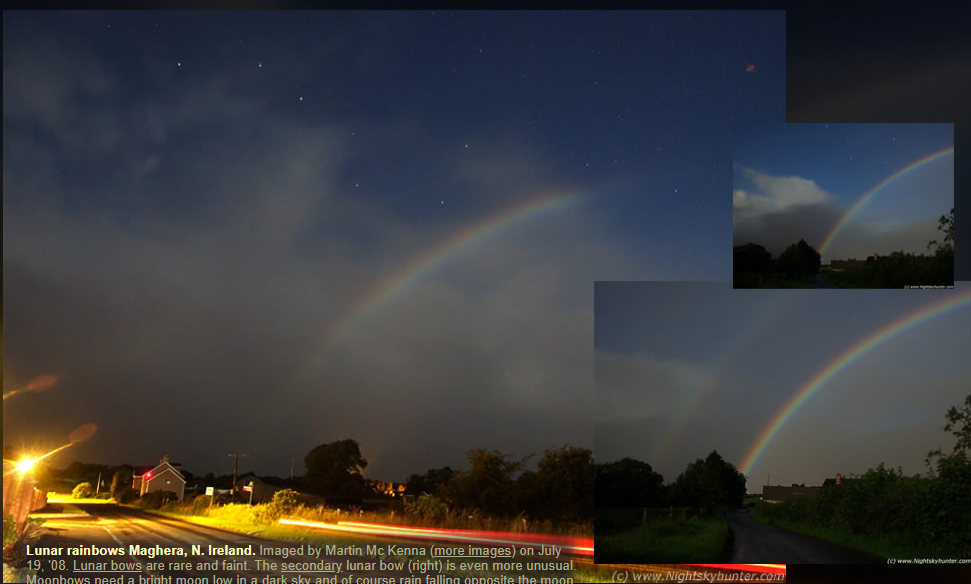Moonbows
Exploring the Enigmatic World of Moonbows
Have you ever witnessed the captivating beauty of a moonbow? Moonbows, also known as lunar rainbows, are a rare atmospheric phenomenon that occurs when moonlight refracts and reflects off water droplets in the air, creating a stunning display of colors. While not as well-known as their daytime counterparts, rainbows, moonbows possess an ethereal charm that is both mysterious and enchanting. In this article, we will delve into the world of moonbows, uncovering their formation, characteristics, and where you might have the best chance of witnessing this celestial spectacle.
The Formation of Moonbows
Moonbows are created through a process similar to that of rainbows. When the moon is low in the sky and its light passes through rain or other water droplets in the air, the light undergoes refraction and reflection. This bending and bouncing of light within the water droplets causes it to separate into its component colors, just like a prism. The result is a circular arc of colors that can be seen opposite the moon in the night sky.
Characteristics of Moonbows
Moonbows share several characteristics with rainbows, but there are also some distinct differences that set them apart. Here are a few notable features of moonbows:
-
Faintness: Moonbows are generally fainter than rainbows due to the lower intensity of moonlight compared to sunlight. This makes them more challenging to spot and adds to their allure.
-
Color Spectrum: Moonbows often display a narrower range of colors compared to rainbows. The most common colors visible in a moonbow are pale shades of red, green, blue, and violet.
-
Wider Arc: Moonbows tend to have a wider arc than rainbows due to the larger size of water droplets that create them. This can result in a more expansive and encompassing display.
-
Secondary Moonbow: In some rare cases, a secondary moonbow may be visible outside the primary moonbow. The secondary moonbow is fainter and has its colors reversed compared to the primary moonbow.
Optimal Conditions for Moonbow Viewing
Witnessing a moonbow is no easy feat. Several factors need to align perfectly for this celestial spectacle to grace the night sky. Here are the optimal conditions for observing a moonbow:
-
Bright Moon: A bright, nearly full moon is essential for the formation of a moonbow. The moon should be low in the sky, preferably below 42 degrees, to ensure that its light passes through a sufficient amount of water droplets.
-
Dark Sky: Moonbows are best observed in areas with minimal light pollution. A dark sky allows the faint colors of the moonbow to stand out more vividly against the backdrop of darkness.
-
Falling Rain: Rainfall opposite the moon is crucial for the creation of a moonbow. The raindrops act as the canvas on which the moonlight paints its colorful masterpiece.
Prime Locations for Moonbow Sightings
Certain locations around the world offer a higher likelihood of witnessing a moonbow due to their unique geographical features and weather conditions. Here are a few renowned spots for experiencing the magic of moonbows:
-
Cumberland Falls, Kentucky, USA: Known as the "Niagara of the South," Cumberland Falls is famous for its frequent moonbow sightings. The combination of a powerful waterfall and ideal lunar conditions makes this location a prime spot for moonbow enthusiasts.
-
Victoria Falls, Zambia/Zimbabwe: The majestic Victoria Falls, one of the world's largest waterfalls, also offers occasional moonbow displays. The spray from the falls combined with a clear sky and a bright moon can create a mesmerizing lunar rainbow.
-
Iguazu Falls, Argentina/Brazil: This awe-inspiring waterfall system, shared by Argentina and Brazil, is another location where moonbows can occasionally be witnessed. The cascading water and the right lunar phase can produce a breathtaking lunar spectacle.
-
Isle of Skye, Scotland: With its rugged coastline and frequent rainfall, the Isle of Skye provides an ideal setting for moonbow sightings. Its remote location and dark skies make it a promising destination for those seeking to capture the elusive lunar rainbows.
The Magic of Moonbows
Witnessing a moonbow is an experience that leaves a lasting impression on those fortunate enough to see it. The combination of the moon's gentle glow, the delicate colors suspended in the night sky, and the rarity of the event creates an otherworldly ambiance that is truly magical. While moonbows may be elusive, their ephemeral beauty reminds us of the wonders that nature has in store for those who are patient and observant.
So, keep your eyes to the sky on a moonlit night, especially during or after a rainfall, and who knows? You might just catch a glimpse of a moonbow—a celestial phenomenon that will leave you awestruck and with memories to cherish for a lifetime.

Lunar rainbows Maghera, N. Ireland. Imaged by Martin Mc Kenna (more images) on July 19, '08. Lunar bows are rare and faint. The secondary lunar bow (right) is even more unusual. Moonbows need a bright moon low in a dark sky and of course rain falling opposite the moon. Martin says "I have seen perhaps six or so moonbows in my life and each one of them was worth seeing and unforgettable to say the least. I recall spending an entire night out during the Winter this year in a field getting soaked by rain and hail trying to catch this very rare phenomena." Images ©M. Mc Kenna, shown with permission.
Note: this article has been automatically converted from the old site and may not appear as intended. You can find the original article here.
Reference Atmospheric Optics
If you use any of the definitions, information, or data presented on Atmospheric Optics, please copy the link or reference below to properly credit us as the reference source. Thank you!
-
<a href="https://atoptics.co.uk/blog/moonbows/">Moonbows</a>
-
"Moonbows". Atmospheric Optics. Accessed on November 25, 2024. https://atoptics.co.uk/blog/moonbows/.
-
"Moonbows". Atmospheric Optics, https://atoptics.co.uk/blog/moonbows/. Accessed 25 November, 2024
-
Moonbows. Atmospheric Optics. Retrieved from https://atoptics.co.uk/blog/moonbows/.